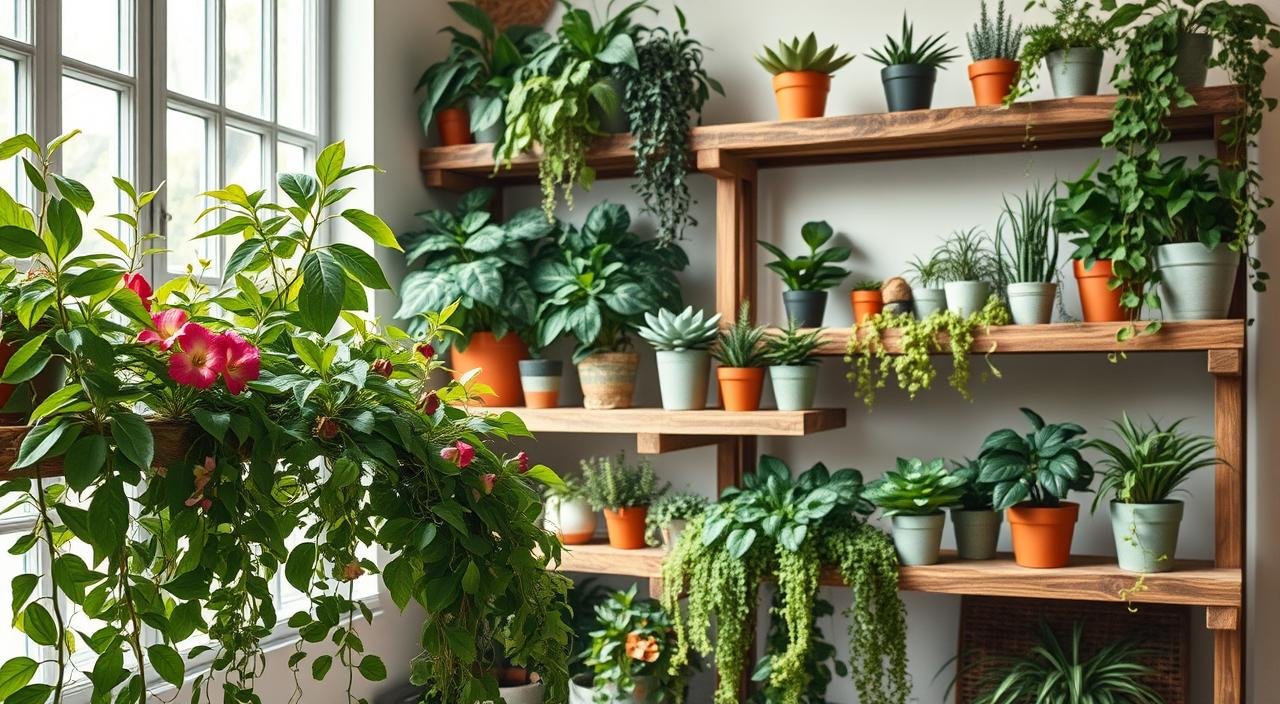Did you know 80% of houseplants thrive better when matched to their indoor environment instead of forcing you to overhaul your home’s conditions1? Successful indoor gardening starts with selecting plants that naturally adapt to your space. Snake Plants (Sansevieria), for instance, tolerate low light better than any other houseplant1, while Philodendron vines thrive under office fluorescent lights1. Overwatering kills more plants than neglect2, and Bromeliads now cost half what they did a decade ago1, making them accessible for modern indoor gardening. By prioritizing plant compatibility over aesthetics alone, you ensure lush growth without constant adjustments.
Key Takeaways
- Pick plants suited to your home’s light—Snake Plants for dim corners1.
- Avoid overcrowding: leave 6 inches between plants and furniture for airflow2.
- Self-watering pots from brands like My City Plants reduce maintenance2.
- Over 80% of plants need light matching their natural habitat1.
- Avoid leaving plants in cars during summer to prevent heat damage1.
Understanding the Benefits of Indoor Plants
https://www.youtube.com/watch?v=e1OibKPjEJg
Modern lifestyles keep people indoors over 80% of the time3, making indoor plant benefits critical for well-being. These living decor items improve health, mood, and space aesthetics. From toxin removal to mental clarity, houseplants create spaces that nourish both body and soul.
Patients in rooms with plants used 22% less pain medication and left the hospital sooner, per a 2002 study4.
Air Quality Improvement
Houseplants act as natural air filters. NASA research founds spider plants and peace lilies remove VOCs like formaldehyde, though large quantities are needed to match air purifiers4. Snake plants release oxygen overnight, aiding sleep. Pairing plants like areca palms improves humidity, easing dry indoor air.
Mental Health Boost
Indoor plants reduce stress hormones and boost focus. Office workers near greenery saw 47% less anxiety and 12% faster task completion4. Schools using indoor plant ideas like fern displays saw students score higher on attention tests. Even brief interactions with plants lower heart rates, creating calming effects.
Aesthetic Appeal
Houseplants turn spaces into living art. Indoor plant ideas like hanging vines or terrariums add visual interest. The Rural Development Administration of South Korea recommends one small and one large plant per 6m² to balance decor and health gains3. Grouping plants by size or texture creates dynamic arrangements without clutter.
Every leaf offers more than beauty—it’s a science-backed investment in health and happiness.
Assessing Your Space and Environment
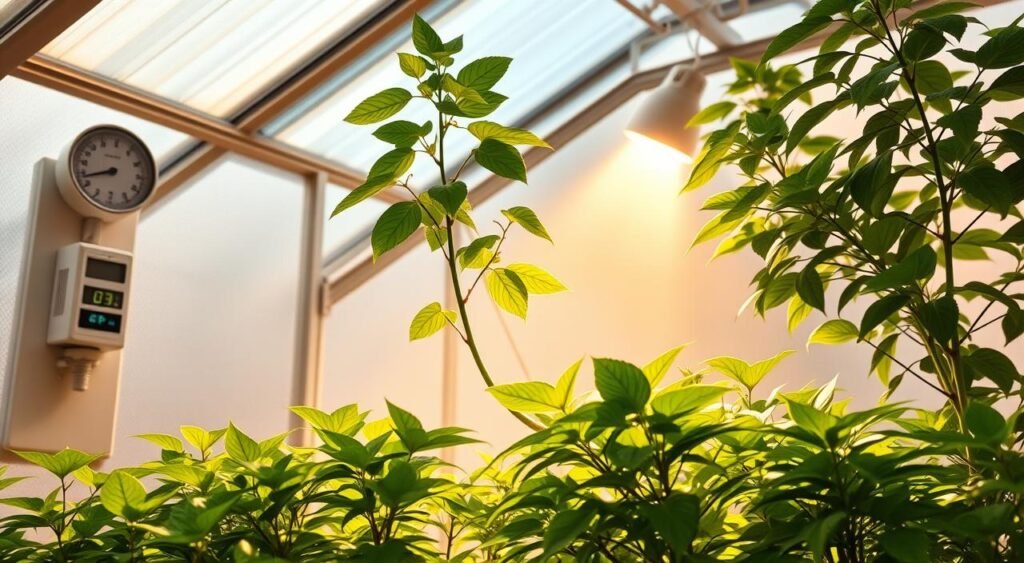
Before selecting plants, evaluate your home’s light and moisture to ensure healthy growth. Indoor gardening success starts with matching plants to their ideal conditions. Observe where sunlight enters rooms and test humidity levels to avoid common plant care mistakes.
“Light and humidity are the cornerstones of plant health—get them right, and your plants will thrive.”
Light Conditions
Start by categorizing your space’s light:
- North-facing windows: Ideal for low-light plants like pothos or ferns. These areas receive indirect light and minimal direct sun.
- East/west-facing windows: Bright indirect light here suits most indoor plants. Plants like snake plants or ZZ plants adapt well to these conditions5.
- South-facing windows: Full sun lovers, such as citrus trees or hibiscus, need these spots. Use sheer curtains to diffuse intense rays in summer.
Humidity Levels
Test moisture levels with simple methods: place a slice of bread in a sealed bag. Mold growth within 24 hours signals high humidity5. Bathrooms often have 60%+ humidity, perfect for tropical plants like orchids. Dry spaces, like heated offices, may need misters or humidifiers to prevent leaf browning6.
Pairing plants with their preferred humidity zone avoids stress. Snake plants prefer dry air, while peace lilies need misting in low-humidity homes5. Indoor plant tips include grouping plants to create microclimates or using pebble trays under pots to boost moisture.
Matching plants to light and humidity ensures they stay healthy. This foundational step in plant care reduces failure rates and boosts your green thumb confidence.
Popular Indoor Plant Varieties
https://www.youtube.com/watch?v=PIp-pxxLe6I
Explore four best indoor plants that combine beauty and resilience. These easy indoor plants thrive in diverse settings, making them top choices for any home.
Snake Plant
Snake Plant (Sansevieria) stands out with its upright leaves and air-purifying traits. It can grow from 8 inches to 12 feet tall and needs watering as little as once a month7. This houseplant adapts to low light and drought, making it ideal for busy lifestyles8.
Pothos
Pothos (Epipremnum aureum), or devil’s ivy) flourishes in low to bright indirect light8. Its variegated vines trail gracefully, and it’s a top seller on sites like The Sill9. Water every one to two weeks when soil dries7.
Peace Lily
Peace Lily (Spathiphyllum) blooms creamy white flowers and thrives at 65–80°F8. Priced at $55 on plants.com7, it prefers weekly watering and indirect light. Its glossy leaves improve air quality9.
Spider Plant
Spider Plant (Chlorophytum) produces baby “spiderettes” for easy propagation7. This easy indoor plant costs $25 at Walmart and grows best in bright indirect light7. Water weekly, and watch it trail from hanging pots9.
Plant Care Basics
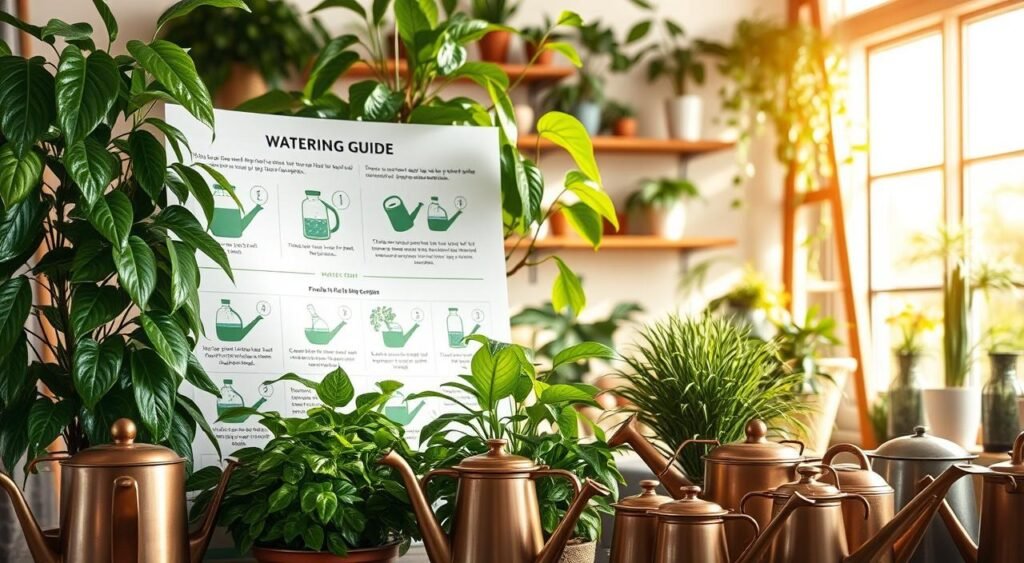
Mastering plant care ensures indoor plants thrive. Start with proper watering to avoid overwatering, the top killer of indoor plants10. Let soil dry slightly between waterings—most need weekly hydration but adjust for your environment10.
Watering Techniques
- Test soil moisture with your finger 1-2 inches deep before watering11.
- Use room-temperature water to avoid shocking roots12.
- Reduce watering in winter when growth slows11.
Soil Requirements
Choose well-draining soil mixes based on plant type. Cacti prefer gritty blends, while ferns need peat-based moisture-retaining soil10. Always use pots with drainage holes to prevent root rot12. Terra cotta pots dry faster than plastic ones12.
| Plant Type | Recommended Soil |
|---|---|
| Succulents | Sandy/gritty mix |
| Ferns | Peat-based mix |
| Tropical plants | Standard potting soil with perlite |
Fertilization
Fertilize during active growth (spring-fall) with a balanced liquid fertilizer every 2-4 weeks10. Reduce to monthly in winter. Use 12-36-14 formulas for flowering plants like Peace Lilies10. Slow-release pellets work for forgetful gardeners12.
“Fertilize less, not more—most indoor plants need fewer nutrients than you think.” – Indoor Gardening Guide
Follow these guidelines to avoid overfeeding, which can burn roots. Always dilute fertilizers to half strength for safety12.
Choosing Low-Maintenance Options
For those new to indoor gardening, easy indoor plants like the ZZ plant thrive with minimal attention. These best indoor plants survive irregular watering and low light, making them perfect for beginners.
Best Plants for Beginners
- ZZ Plant: Water every 2-3 weeks when soil is dry13.
- Money Tree: Water weekly when topsoil feels dry13.
- Aloe Vera: Grows 2–36 inches tall and adapts to neglect14.
Drought-Resistant Choices
Cacti and succulents lead the way in indoor plant tips. The Ponytail Palm survives a month without water14, while Echeveria stores water in its leaves. For shaded spots, the Jade Plant grows slowly but stays hardy14.
“Drought-resistant plants like Haworthia need watering only when soil is bone-dry.”
Pair these choices with these indoor plant tips: use well-draining soil and avoid overwatering. Even busy lifestyles can accommodate these resilient greens, proving that easy indoor plants deliver beauty without stress1314.
Selecting Indoor Plants for Different Rooms
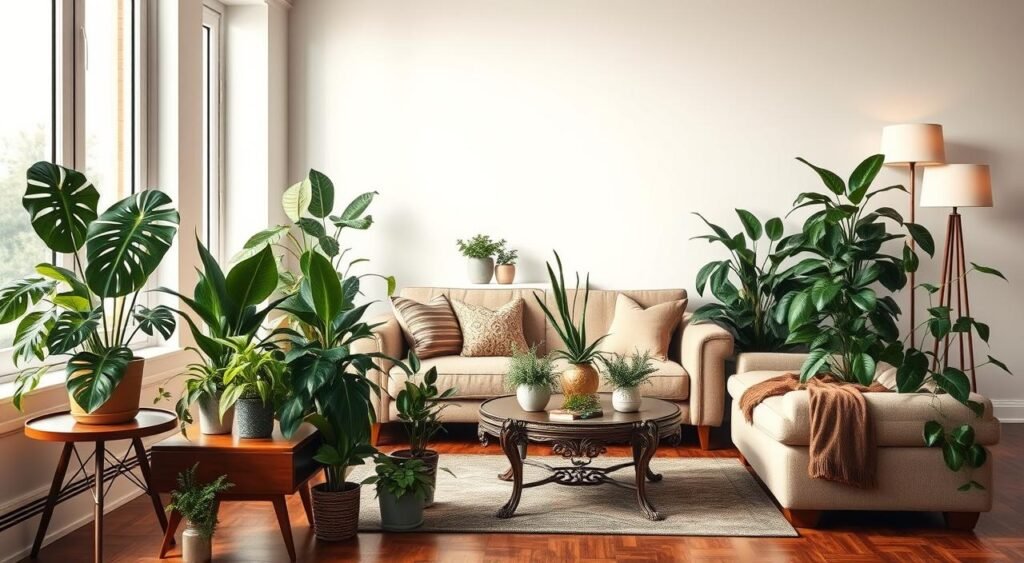
Selecting indoor plant ideas starts with matching plants to each room’s light and moisture. Indoor plant decor thrives when paired with space-specific care. Let’s explore top picks for living rooms, bedrooms, and kitchens.
Living Room Options
Eastern-facing rooms offer morning sun ideal for plants like Bird of Paradise, which thrive in weekly watering and bright indirect light15. Eastern light reduces heat stress16. Try these choices:
- Bird of Paradise: Weekly watering in bright indirect light15.
- Rubber Tree: Weekly watering, prefers bright to moderate light15.
- Philodendron: Weekly watering and indirect light15.
Bedroom Beauties
Bedrooms benefit from plants like snake plants or spider plants, which release oxygen at night15. Opt for:
- Rubber Plant: Weekly watering in moderate light15.
- Peace Lily: Weekly watering and indirect light15.
Kitchen-Friendly Plants
Kitchens with steam and partial shade suit humidity-loving choices like:
- Ferns: Weekly watering in bright to low light15.
- Air Plants: Daily misting and indirect light15.
- Pothos: Weekly watering in bright indirect light15.
Tips for Plant Arrangement
Effective indoor plant decor relies on thoughtful arrangement. Grouping and layering houseplants creates visually striking spaces while meeting plant needs. Start by applying design principles to turn individual plants into cohesive indoor plant ideas.
Grouping Plants
Pairing plants in odd-numbered clusters adds harmony. Group three or five varieties together for a balanced look17. Choose species with similar light and water needs to simplify care. For example, Peace Lilies and ferns thrive in moist conditions, making them ideal partners18. Follow these rules:
- Combine plants with contrasting textures (e.g., spiky vs. rounded leaves)
- Ensure at least one plant in the group has trailing vines to add movement
- Leave 6-8 inches between pots to maintain airflow and prevent disease
Creating Levels
Vertical arrangements maximize space using tiered displays. Place tall plants at the back, medium ones in the center, and small varieties at the front. Use these strategies to build dynamic layouts:
- Hang trailing plants like Pothos from shelves or ceilings
- Stack pots on tiered stands or windowsills
- Balance greenery with decorative items like ceramic pots or driftwood
| Design Principle | Implementation |
|---|---|
| Odd-numbered groupings | 3-5 plants with similar care needs |
| Vertical layers | Stack pots on shelves or use hanging planters |
| Color coordination | Pair plants with complementary foliage hues |
These strategies transform houseplants into living art, enhancing both aesthetics and functionality. Pairing moisture-loving varieties together creates microclimates that improve plant health and indoor plant decor impact.
Decorating with Indoor Plants
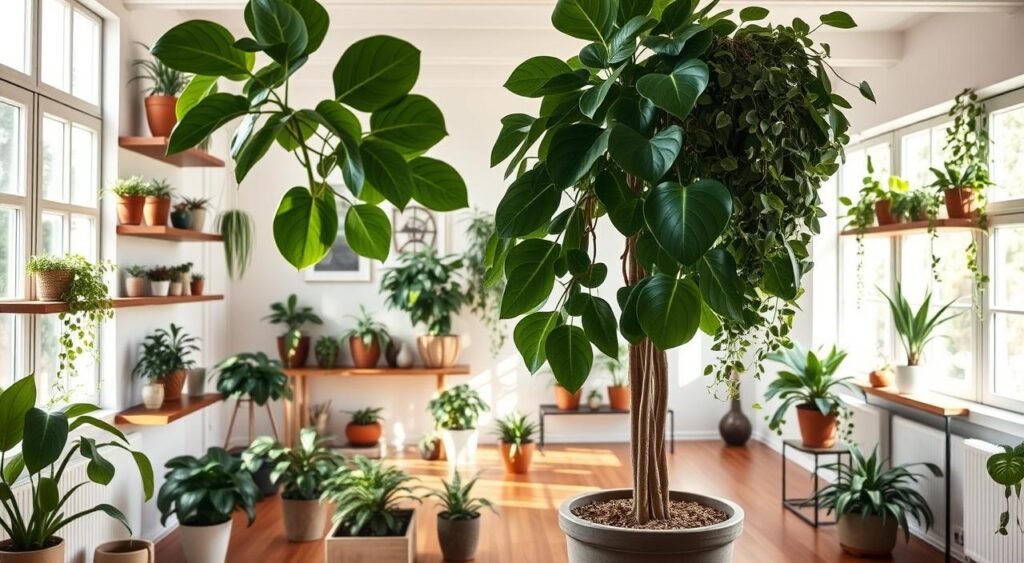
Transform spaces with indoor plant decor that blends beauty and function. Pots and planters aren’t just containers—they’re design elements. Choose materials like ceramic for elegance, terracotta for breathability, or sleek plastic for modern aesthetics. Always ensure pots have drainage holes to prevent root rot19. Size matters too: pair small plants with compact pots and large specimens like fiddle leaf figs with bold, sturdy containers.
- Indoor gardening trends prioritize stylish displays. Pair multiple plants on tiered stands or repurpose furniture like bar carts as mobile plant stations20.
- Plant stands add vertical interest. Floating shelves or wall-mounted hooks maximize space, ideal for apartments or small rooms20.
- Group plants of varying heights and textures to create dynamic indoor plant ideas. A study shows 75% of plant enthusiasts use clusters to enhance room ambiance19.
Pro tip: Match container colors to room palettes. Neutral pots blend seamlessly, while bright hues add pops of color. Rotate plants on stands to ensure even light exposure and balance growth19. With creative setups, even small spaces can become green havens.
| Material | Benefits | Best For |
|---|---|---|
| Ceramic | Stylish, moisture-resistant | Larger plants |
| Woven rattan | Natural, rustic appeal | Tropical plants |
| Recycled plastic | Lightweight, eco-friendly | Modern spaces |
Seasonal Considerations
Seasons demand changes in plant care routines to keep indoor plants thriving. Winter’s cold and summer’s heat each pose unique challenges. Follow these indoor plant tips to adapt care year-round.
Adjusting Care in Winter
Colder months require careful adjustments. Keep indoor plants away from drafty windows and cold air vents. Water less frequently—most plants enter dormancy, needing 30-50% less moisture than in summer21. Use room humidifiers or pebble trays to maintain 40-60% humidity, preventing leaf curl21. Inspect plants every 2 weeks for pests like spider mites21.
- Wrap plants in paper bags during outdoor moves21
- Isolate new plants for 30-60 days to prevent pest spread21
- Move citrus and hibiscus indoors when temps drop below 50°F22
Summer Plant Care Tips
Hot weather demands proactive steps. Shield plants from direct noon sun to prevent leaf scorch. Increase watering frequency but avoid overwatering—check soil moisture daily for tropical varieties. Mist foliage of ferns or peace lilies during AC use22.
| Plants to Overwinter Indoors | Plants to Discard After Frost |
|---|---|
| Snake Plant, Pothos, Succulents | Marigolds, Petunias, Verbena22 |
Bring container plants inside before first frost22. Use sheer curtains on sunny windows to reduce light intensity. Rotate plants weekly for even growth.
Dealing with Common Indoor Plant Pests

Plant care for houseplants requires vigilance to prevent pests from harming indoor gardening efforts. Early detection stops infestations before they spread. Regular inspections using a 10x magnifying glass can spot pests like aphids or mealybugs early23.
Identifying Pest Issues
Common pests like spider mites, scale, and fungus gnats thrive in indoor settings. Spider mites (1/50th inch) cause stippled leaves on dracaena and ivy23. Mealybugs (3/16 inch) form cotton-like clusters on stems, damaging plants like citrus and figs24. Fungus gnat larvae feed on roots, causing wilting in overwatered soil23.
| Pest | Signs | Host Plants |
|---|---|---|
| Spider Mites | Yellow speckles, webbing | Dracaena, Ivy |
| Mealybugs | White cottony masses | Citrus, Figs |
| Fungus Gnats | Wriggling larvae in soil | Moist-soil plants |
Organic Pest Control Solutions
Organic methods work best when applied early. Neem oil (effective for 2 weeks) disrupts insect lifecycles23. Insecticidal soap smothers softbodied pests like aphids and scale24. Yellow sticky traps catch flying pests like whiteflies and thrips23.
- Neem oil for scale and whiteflies (applied every 7-14 days)
- Insecticidal soap for spider mites and mealybugs
- Isolate new plants for 14 days to prevent spread23
“Prevention starts with healthy plants—proper watering and airflow reduce pest attraction.”
Consistent monitoring and targeted treatments protect indoor gardening projects. Using organic solutions like rubbing alcohol for mealybugs or introducing predatory mites maintains houseplant health without harsh chemicals25.
Resources for Further Learning
Expanding your indoor gardening knowledge ensures plants thrive. Over 250 indoor plant varieties exist, each requiring specific care routines26. Avoid common issues like overwatering, which causes 70% of plant losses26. These resources provide actionable steps to master plant care.
Books and Online Guides
Books like *The New Tropical House Plants* by David Squire detail species-specific needs. Online platforms like the Missouri Botanical Garden’s guide offer light and humidity requirements. Apps like Houseplant Journal track watering schedules and alert users to pest signs. Social media channels like @HouseplantTips share indoor plant tips for troubleshooting yellow leaves or leaf drop.
Local Gardening Clubs and Workshops
Join local horticulture societies or community college courses. Workshops often cover light management—east-facing windows provide 5,000–8,000 ft-c light, while north-facing windows offer 20% less27. Sessions may explain optimal spring repotting or pest identification. Nurseries host events demonstrating how to adjust care for seasonal shifts, like winter humidity drops below 20%28.
FAQ
What are the best indoor plants for beginners?
How can indoor plants improve air quality?
What factors should I consider when selecting indoor plants?
How do I know if my plant needs water?
Where should I place indoor plants in my living room?
What type of pots are best for indoor plants?
How do seasonal changes affect indoor plant care?
What are some common indoor plant pests?
Can indoor plants really boost mental health?
What are some design tips for arranging indoor plants?
Source Links
- Selecting Indoor Plants | University of Maryland Extension – https://extension.umd.edu/resource/selecting-indoor-plants
- Home Plant Guide: How To Choose The Best Plants For Your Home, Where to Place Them, & How to Care for Them • My City Plants – https://mycityplants.com/plant-decor/how-to-choose-the-best-plants-for-your-home/
- Effects of Indoor Plants on Human Functions: A Systematic Review with Meta-Analyses – https://pmc.ncbi.nlm.nih.gov/articles/PMC9224521/
- 7 Science-Backed Benefits of Indoor Plants – https://www.healthline.com/health/healthy-home-guide/benefits-of-indoor-plants
- The Best Houseplants for Your Environment | HRC – https://houseplantresourcecenter.com/2020/04/the-best-houseplants-for-your-environment/
- Finding Your Green Companions: A Guide to Choosing the Best Indoor Plants for Your Space – Dodola – https://mydodola.com/blog/finding-your-green-companions-a-guide-to-choosing-the-best-indoor-plants-for-your-space/
- These Hard-to-Kill Houseplants Are Great for Beginners – https://www.goodhousekeeping.com/home/gardening/advice/g1285/hard-to-kill-plants/
- 15 Easy Indoor Plants for Beginners – Can’t Kill Houseplants – https://www.provenwinners.com/leafjoy/easy-indoor-plants
- The 42 Most Popular Houseplants for Your Home – https://www.realsimple.com/home-organizing/gardening/indoor/popular-house-plants
- Basic Houseplant Care – https://newgarden.com/learning-center/basic-houseplant-care
- Top Ten Plant Care Tips for Houseplants & Indoor Plants – The Sill – https://www.thesill.com/blogs/plants-101/top-ten-plant-care-tips?srsltid=AfmBOoqSU1d3d2g7N_jzHQZV7xMX1dXxaFG6c-k8xWmkkb4B8bj1iIwo
- Houseplant Basics – https://costafarms.com/blogs/get-growing/houseplant-basics?srsltid=AfmBOoqiZZMSgJ3V9eC8I8z4a9CIn94YpDyung7CEAfxV6GuCdW9-vIy
- 35 Low-Maintenance Plants That Will Thrive in Any Room – https://www.housebeautiful.com/lifestyle/gardening/g31355906/easy-low-maintenance-plants/
- 38 Low-Maintenance Indoor Plants That Won’t Require Your Constant Attention – https://www.thespruce.com/low-maintenance-indoor-plants-8622418
- Your Guide to Choosing a Plant for Every Room in Your House – https://www.realsimple.com/home-organizing/gardening/indoor/best-indoor-plants
- PDF – https://uthort.tennessee.edu/wp-content/uploads/sites/228/2023/11/W1128A.pdf
- How to Arrange Plants In Your Living Room to Add Natural Style – https://www.bhg.com/gardening/houseplants/projects/decorating-with-houseplants/
- Tips to properly arrange houseplants – https://www.promixgardening.com/en/tips/interior-design-with-indoor-plants
- 15 Ideas for Decorating with Plants – Add Life & Color to Any Room – https://www.provenwinners.com/leafjoy/decorating-with-plants
- 27 Great Ways to Decorate With Plants – https://www.thespruce.com/ways-to-decorate-with-plants-4049334
- How To Keep Indoor Plants Alive During Winter – HILLS Properties – https://www.hillsproperties.com/blog/how-to-keep-indoor-plants-alive-during-winter/
- When & How to Bring Outdoor Plants Inside for Winter – Garden Design – https://www.gardendesign.com/how-to/bring-outdoor-plants-inside.html
- Managing insects on indoor plants – https://extension.umn.edu/product-and-houseplant-pests/insects-indoor-plants
- How to Spot 6 Common Houseplant Pests and Get Rid of Them Naturally – https://www.bhg.com/gardening/houseplants/care/common-houseplant-pests/
- Houseplant pests – Agricultural Biology – https://agsci.colostate.edu/agbio/ipm-pests/houseplant-pests/
- Chapter 12: Indoor Plants – https://pressbooks.lib.vt.edu/emgtraining/chapter/12/
- Growing Indoor Plants with Success – https://extension.uga.edu/publications/detail.html?number=B1318&title=growing-indoor-plants-with-success
- Houseplant Care – Smithsonian Gardens – https://gardens.si.edu/learn/educational-resources/plant-care-sheets/houseplant-care/

